UV Fluorescent BGA Meter Blue-Green Algae Sensor for Aquatic Environment Monitoring
Features
① Single UV Light Source Technology
The sensor employs a specialized UV light source to excite chlorophyll fluorescence in algae, effectively filtering out interference from suspended particles and chromaticity. This ensures highly accurate and stable measurements even in complex water matrices.
② Reagent-Free & Pollution-Free Design
No chemical reagents are required, eliminating secondary pollution and reducing operational costs. This eco-friendly design aligns with sustainable water management practices.
③ 24/7 Online Monitoring
Capable of uninterrupted, real-time operation, the sensor provides continuous data for early detection of algal blooms, compliance reporting, and ecosystem protection.
④ Automatic Turbidity Compensation
Advanced algorithms dynamically adjust measurements to account for turbidity fluctuations, ensuring reliable performance in sediment-rich or variable-quality water.
⑤ Integrated Self-Cleaning System
A built-in wiper mechanism prevents biofilm accumulation and sensor fouling, minimizing manual maintenance and ensuring long-term reliability in harsh aquatic environments.


Product Paramenters
| Product Name | Blue-Green Algae sensor |
| Measurement method | Fluorescent |
| Range | 0-2000,000 cells/ml Temperature: 0-50℃ |
| Accuracy | ±3%F.S. Temperature: ±0.5℃ |
| Power | 9-24VDC(Recommend12 VDC) |
| Size | 48mm*125mm |
| Material | 316L Stainless Steel |
| Output | RS-485, MODBUS protocol |
Application
1. Environmental Water Quality Protection
Monitor lakes, rivers, and reservoirs to detect harmful algal blooms (HABs) in real time, enabling timely interventions to protect aquatic ecosystems and public health.
2. Drinking Water Safety
Deploy in water treatment plants or raw water intake points to track algal concentrations and prevent toxin contamination in potable water supplies.
3. Aquaculture Management
Ensure optimal water conditions for fish and shellfish farming by monitoring algae levels, preventing oxygen depletion and fish kills caused by excessive blooms.
4. Coastal and Marine Monitoring
Track algal dynamics in coastal zones, estuaries, and marinas to mitigate ecological risks and comply with marine environmental regulations.
5. Research and Climate Studies
Support scientific research on algal growth patterns, eutrophication trends, and climate change impacts with high-resolution, long-term data collection.










